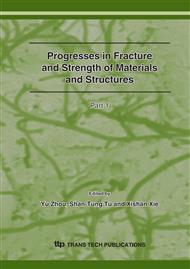p.2656
p.2660
p.2664
p.2668
p.2672
p.2676
p.2681
p.2687
p.2691
Structural Response and Behavior Analyses of Steel Joint Components at Elevated Temperatures
Abstract:
The structural response and behavior of steel joint under fire condition are analyzed in this paper. A simplified model for moment-rotation relationship of the end-plate bolted connections at elevated temperatures is proposed. This model is convenient and effective to describe the characteristics of extended end-plate joint and can be applied to evaluate the structural response and fire-resistant performance under static-load and thermal effects. The results of finite element analysis and related experiment are also used to validate the proposed model. It is found that the initial rotational stiffness and limit loading-capacity of steel joint components are affected significantly by the degradation of materials and the dimensions of components.
Info:
Periodical:
Pages:
2672-2675
Citation:
Online since:
September 2007
Authors:
Price:
Сopyright:
© 2007 Trans Tech Publications Ltd. All Rights Reserved
Share:
Citation:


